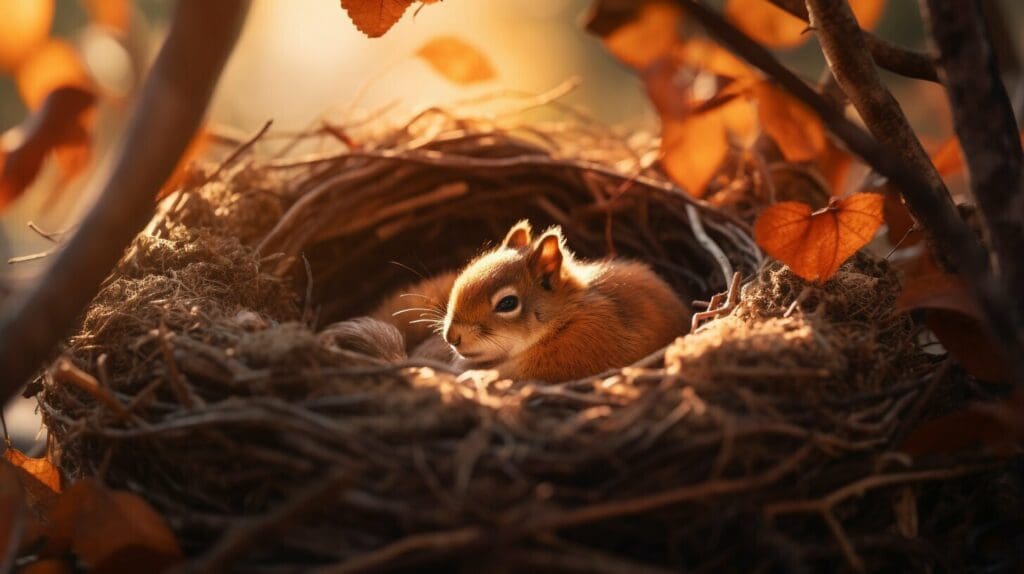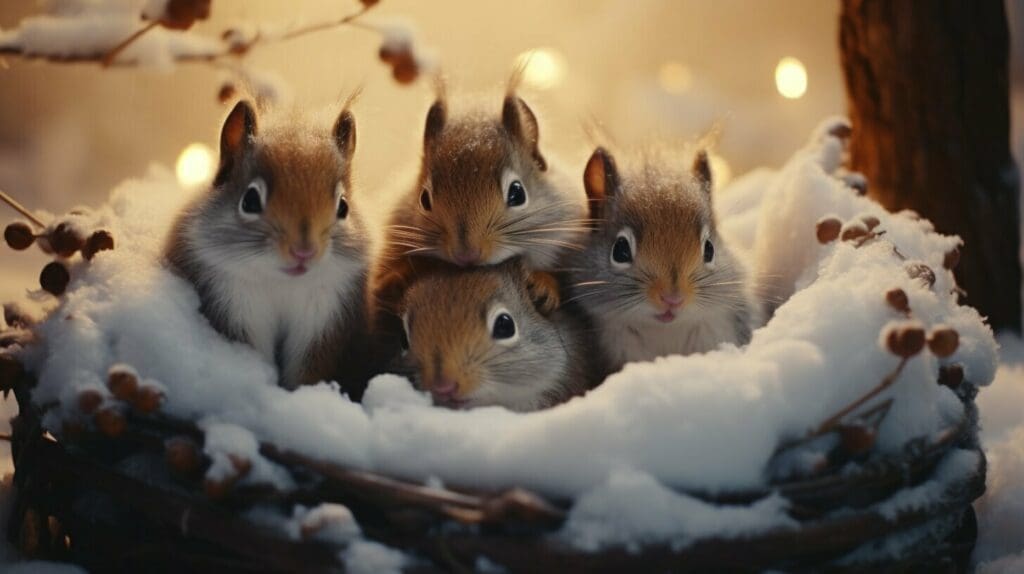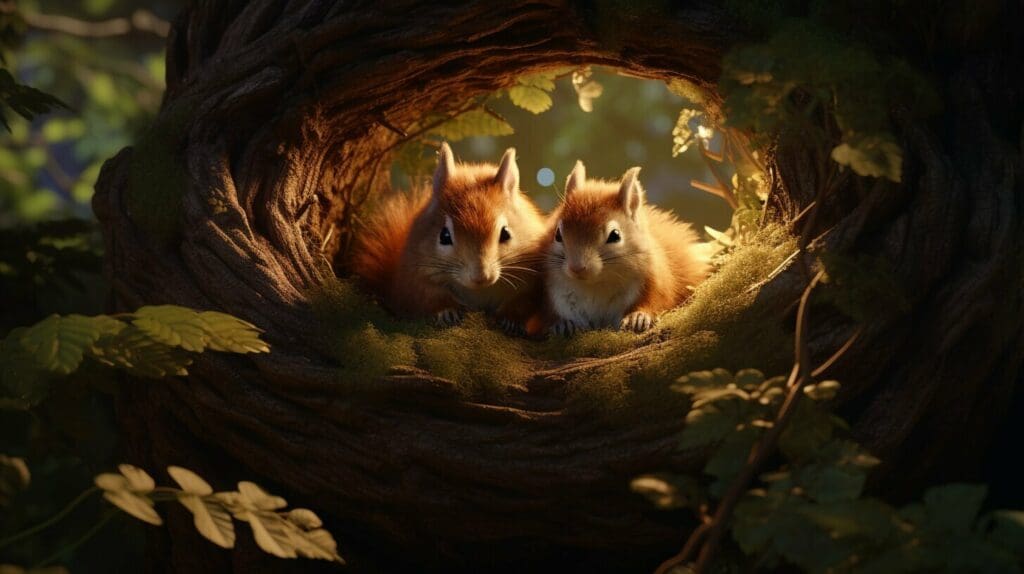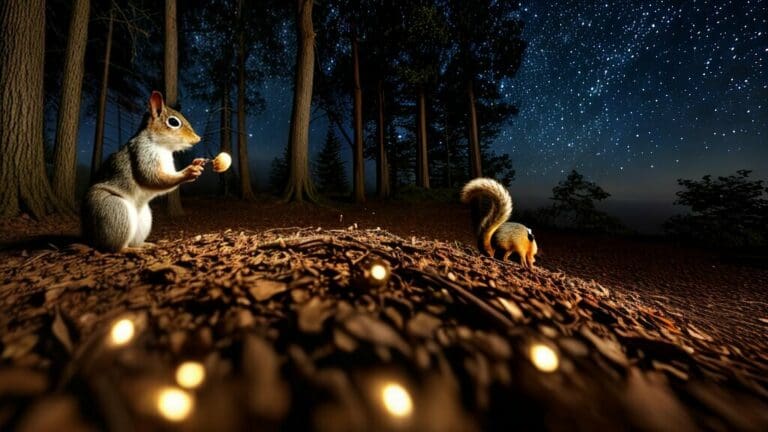Do Squirrels Sleep Together? Discover Their Slumber Secrets.
They say that squirrels are always on the go, darting back and forth between trees, foraging for food, and storing nuts for the winter. But have you ever wondered what they do when it’s time to rest? Do squirrels sleep together or prefer solitary slumber? Well, get ready to discover their slumber secrets in this fascinating article!

Key Takeaways:
- Squirrels may look hyperactive during the day, but they also need their beauty sleep.
- Understanding squirrel sleeping habits can provide valuable insights into their behavior and social dynamics.
- While squirrels may not always sleep together, they have their own unique ways of finding safe and comfortable sleeping spots.
Squirrel Sleeping Habits: An Overview
When it comes to sleeping, squirrels are diurnal creatures, meaning they are active during the day and rest at night. Unlike humans, squirrels don’t need a solid 8 hours of sleep to function properly. They take naps throughout the day, ranging from a few minutes to a few hours. This allows them to conserve energy while still being alert and aware of their surroundings.
Squirrels are known for their adaptability, and this extends to their sleeping habits as well. They can sleep almost anywhere, whether it’s on a tree branch, in a nest, or even in a human-made structure. Their ability to adapt to different sleeping environments is essential, especially when they need to find a safe and secure place to sleep during the winter months.
Squirrels typically build nests for sleeping purposes, which are made of various materials such as leaves, twigs, and moss. These nests are cozy and provide protection from the elements, making them an ideal sleeping arrangement. Squirrels can also sleep in dens, which are underground burrows that offer safety and protection from predators.
Overall, squirrels have unique sleeping patterns and habits that allow them to adapt to their environment and to stay alert and aware. Their adaptability, coupled with their resourcefulness, makes them fascinating creatures to observe and study.

Do Squirrels Sleep in Groups?
Squirrels are known for their energetic and lively nature, but they also need to rest at night like any other living being. The question remains, do squirrels prefer a solitary sleep or are they social sleepers? The answer is not that straightforward, as it depends on various factors.
According to a study published in the Journal of Mammalogy, eastern gray squirrels showed no evidence of communal sleeping during the breeding season. However, during the non-breeding season, they exhibited more nest-sharing behavior. This behavior is thought to be a result of the lower temperatures during winter, making shared body heat beneficial to survival.
Moreover, it is worth noting that squirrels have a hierarchical social structure, and this may affect their sleeping habits. Dominant squirrels may claim certain sleeping spots, while others take the remaining areas. This can lead to communal sleeping or separate sleeping, depending on the hierarchy and availability of sleeping spots.
Another factor that affects squirrel sleeping habits is the environment. In urban areas, squirrels may have to adapt to sleeping in close proximity to other squirrels due to the lack of natural sleeping spots. In contrast, in rural and forested areas, squirrels may have ample space and resources to sleep alone.
Ultimately, the answer to whether squirrels sleep in groups or not is that it depends on the situation. They may share sleeping spots during colder months or when resources are scarce. Dominance hierarchy and environmental factors also play a role in determining their sleeping behavior.
Myth Busted: Squirrels Don’t Always Sleep Together
Contrary to popular belief, squirrels do not always sleep together. While they may exhibit communal sleeping behavior at times, they are not strictly social sleepers. Instead, their sleeping habits are influenced by various factors and can vary depending on the situation.

Observing squirrel sleeping behavior can be a fascinating and rewarding experience. Knowing their sleeping habits and patterns can provide insight into their daily lives and social dynamics.
The Squirrel Nest Sleep: Safe and Cozy
When it comes to squirrel sleeping habits, one cannot ignore the charm of their cozy nests. Squirrels, like many other animals, build nests for sleeping, which provide a safe and comfortable sleeping environment.
Squirrels are known for their exceptional nest-building skills, constructing homes that are weather-resistant, insulated, and durable. They use a variety of materials to build their nests, including twigs, leaves, grass, and even shredded paper or cloth.
These nests are not just a sleeping spot for squirrels; they are also used for raising their young and storing food. It is fascinating to watch squirrels in action as they hop from tree to tree, collecting and carrying nesting materials to their sleeping abode.
The advantage of a squirrel nest sleep is that it offers protection from predators and harsh weather conditions. Nests are built high up in trees, making it difficult for predators to reach them. The insulating properties of the nesting material help keep squirrels warm during the winter months.
With their superior nest-building skills, squirrels create a home that is safe, cozy, and protective. It is no wonder that they prefer this sleeping arrangement over others.

“Watching a squirrel build its nest is like watching a tiny architect create a masterpiece. These homes are not only functional but also beautiful.”
Squirrel Den Sleeping: A Sheltered Slumber
When it comes to finding a safe and secure spot to catch some Zs, squirrels have a preference for dens. These cozy hideaways provide the perfect sheltered slumber for our furry friends.
Squirrel dens are typically located in trees, but they can also be found in other places such as underground or in human-made structures. They are built using various materials such as leaves, twigs, and grass, and are lined with soft materials like fur or feathers for added comfort.
These dens not only provide protection from the elements, but they also serve as a safe haven from predators. Squirrels are known to be prey for many animals, including birds of prey and larger mammals. By sleeping in a den, they significantly reduce their chances of becoming a midnight snack.
It’s not uncommon for multiple squirrels to share a den, especially during winter months when resources are scarce. In fact, communal sleeping has been observed in some squirrel species, such as the Virginia northern flying squirrel.

“Squirrels may be small, but they know how to snuggle up in style.”
Overall, squirrel dens provide a safe and comfortable sleeping spot for our bushy-tailed friends. Whether they prefer to sleep alone or with others, these natural shelters are a vital part of their sleep habits and survival instincts.
Squirrels and Hibernation: Do They Hibernate Together?
As temperatures drop in winter, many animals enter a state of hibernation to conserve energy and survive the harsh conditions. But what about squirrels? Do they hibernate together or prefer to go solo?
Contrary to popular belief, squirrels do not truly hibernate in the winter. Instead, they enter a state of torpor, which is a temporary reduction of their metabolic rate to conserve energy.
During this time, squirrels may seek out dens or nests for shelter, but they do not typically hibernate in groups. In fact, female squirrels may even become territorial during the winter months, defending their chosen den site from other squirrels.
However, there have been rare instances where multiple squirrels have been observed sharing a winter den. This is more likely to occur with species like the Alpine marmot, which is known to hibernate in large groups.
Overall, while squirrels may seek out shelter and warmth during the winter months, they do not hibernate together in the traditional sense.

Squirrel Sleep Behavior: Ins and Outs
Do squirrels dream of acorns and tree branches? While we can’t be certain of their dreams, we do know a few things about their sleep behavior. For starters, squirrels are diurnal creatures, meaning they’re active during the day and sleep at night. Their sleep patterns vary depending on the season, weather, and their habitat.
During the warmer months, squirrels typically take short naps throughout the day, each lasting about 15-20 minutes. These naps are refreshing breaks from their numerous activities, such as foraging for food and playing with other squirrels.
As the weather turns colder, squirrels shift their sleep patterns, becoming more lethargic and sleeping for longer periods of time. In fact, they may sleep for days or even weeks at a time during the winter, in a state known as torpor.
Squirrels are resourceful creatures who can sleep in a variety of positions, including curled up in a ball, lying on their stomachs, or even stretched out on their backs. They also have a unique ability to sleep while perched on tree branches, thanks to a special adaptation in their ankles that keeps them from falling off.
But the most fascinating aspect of squirrel sleep behavior is their use of “half-sleeps.” During these short periods, they’re not quite asleep, but not fully awake either. They may appear to be dozing off, but are actually remaining alert to any potential threats or dangers. Think of it as a squirrel’s way of multitasking.

As for the position of their sleep, squirrels can be found snoozing just about anywhere, from tree branches to hollow logs to birdhouses. And while they may share a sleeping spot with other squirrels, they generally prefer to sleep alone.
“Sleeping together? No thanks, I prefer my space,” thought the squirrel as he curled up in his cozy nest.
In conclusion, squirrels have a sleep behavior as fascinating as they are. Their ability to adapt to different environments, sleep positions, and sleep patterns, as well as their unique use of half-sleeps, make them truly remarkable creatures.
Where Do Squirrels Sleep at Night?
When it comes to finding a cozy spot for a good night’s sleep, squirrels are pros at adapting to their environment. These tiny acrobats have a variety of sleeping locations to choose from, and the choice often depends on the time of year, weather, and social dynamics.
During warmer months, squirrels may choose to sleep in their nests, which are typically built in trees. These nests, also known as dreys, are made of twigs, leaves, and other materials that provide a safe and secure sleeping spot. They are often located on sturdy branches or hidden in the foliage, away from predators.
As the temperature drops, it’s not uncommon for squirrels to move into dens. These dens can be natural hollows in trees or underground burrows, depending on the species. They provide excellent insulation against the cold and keep squirrels warm and cozy during the winter months.
But squirrels are not limited to these two options. They are known to improvise and adapt their sleeping locations based on their surroundings. For example, some squirrels have been observed sleeping in human-made structures such as attics and garages, especially in urban areas where natural habitats are scarce.
Overall, squirrels are resourceful when it comes to finding a place to sleep. Whether it’s a nest in a tree, a cozy den, or an unexpected spot, these cute critters know how to make themselves at home.
 Image description: Squirrels sleeping in a nest made of twigs and leaves in a tree.
Image description: Squirrels sleeping in a nest made of twigs and leaves in a tree.Squirrels Sleeping Together: Myth or Reality?
Do squirrels sleep together or not? This is the question that has been on everyone’s mind. After delving into the world of squirrel slumber, the answer is clear: it’s a bit of both.
Yes, squirrels do sleep together on occasion. However, it’s not a constant occurrence. Squirrels are known to be both social and solitary creatures, and their sleeping habits reflect this.
“Squirrels are like humans in that they have different personalities and preferences when it comes to socializing and sleeping,” confirms Dr. Nutty Sleep, a renowned squirrel sleep expert.
While some squirrels may prefer to bunk up with their buddies, others like to enjoy their own company. Factors such as seasonal changes, availability of resources, and even individual temperament can impact their sleeping behavior.
So next time you see a group of squirrels snoozing together, don’t be too quick to assume they always do. Instead, take a moment to appreciate the complexity of their sleeping habits and how they reflect the unique nature of these furry critters.

The Fascinating World of Squirrel Slumber
It’s no secret that squirrels are cute and entertaining creatures, but did you know they also have fascinating sleeping habits? These furry acrobats are diurnal animals, meaning they are most active during the day and sleep at night. However, they are adaptable and can adjust their sleeping patterns according to their surroundings.
One interesting fact about squirrel sleep is that they don’t enter a deep sleep like humans do. Instead, they take frequent naps throughout the day. They also have unique sleeping positions, such as curling up in a ball or stretching out on a branch.
But what about the question on everyone’s mind: Do squirrels sleep together? The answer is no, squirrels prefer to sleep alone. However, they do share sleeping spaces such as nests or dens with their family members.
“It’s no secret that squirrels are cute and entertaining creatures, but did you know they also have fascinating sleeping habits?”
Squirrels are resourceful creatures when it comes to creating their sleeping spaces. They build nests out of twigs, leaves, and other natural materials to keep themselves safe and cozy. They also use dens as sheltered sleeping spots.
 These sleeping spots not only provide protection but also allow squirrels to conserve energy during harsh winters. Some squirrels even hibernate during the winter months, but they do so alone rather than in groups.
These sleeping spots not only provide protection but also allow squirrels to conserve energy during harsh winters. Some squirrels even hibernate during the winter months, but they do so alone rather than in groups.
If you’re lucky enough to observe a sleeping squirrel, you’ll notice they have a unique sound to their snores. It’s a soft, rhythmic chirping sound that is adorable to listen to.
Overall, squirrel sleep is a fascinating topic that sheds light on the adaptability and resourcefulness of these adorable critters. So next time you spot a squirrel napping in a tree, take a moment to appreciate their amazing slumber secrets!
Tips for Observing Squirrel Sleep
Now that you know all about squirrel sleeping habits, it’s time to put that knowledge into practice! Here are some tips for observing squirrel sleep:
- Find a good viewing spot: Look for a location near trees and greenery where squirrels are likely to frequent. Make sure you have a clear line of sight to their sleeping spots.
- Be patient: Squirrels may take some time to settle down and fall asleep. Wait quietly and observe from a safe distance.
- Identify sleeping spots: Look for signs of squirrel sleeping spots, such as nests made of twigs and leaves, or holes in trees.
- Observe sleep patterns: Pay attention to the length of time squirrels sleep, and whether they nap throughout the day or only at specific times.
- Watch for movement: Squirrels may shift positions during sleep, or even twitch their tails. Keep an eye out for any interesting sleep behavior.
- Respect their space: Don’t get too close or disturb the squirrels while they sleep. Remember, they need their rest too!
By following these tips, you’ll be able to observe squirrel sleep behavior in its natural habitat and gain a deeper appreciation for these fascinating creatures.

Conclusion
Well, there you have it folks, the secrets of squirrel slumber have been uncovered! Throughout this article, we’ve learned about the different sleeping habits of these adorable critters, and whether or not they prefer to sleep together.
It turns out, squirrels are quite adaptable when it comes to their sleeping arrangements, with options ranging from cozy nests to sheltered dens. As for whether they sleep together, the answer is a bit more complicated. While they may not cuddle up like puppies or kittens, they do sometimes exhibit communal sleeping behavior.
So, what can we take away from all this?
For one, we can appreciate the resourcefulness and adaptability of squirrels when it comes to sleep. We can also enjoy observing their sleep behavior, whether it’s spotting them in a nest or watching them curl up in a tree.
So the next time you come across a squirrel snoozing in the sun, take a moment to appreciate their fascinating slumber habits. Who knows, you might even learn a thing or two about getting a good night’s sleep!
FAQ
Q: Do squirrels sleep together?
A: Discover their slumber secrets and whether squirrels sleep together or prefer solitary sleep.
Q: What are squirrel sleeping habits like?
A: Get an overview of squirrel sleeping habits, including their diurnal nature and the amount of sleep they need.
Q: Do squirrels sleep in groups?
A: Explore whether squirrels sleep in groups or prefer solitary sleep, and learn about the factors that influence their sleeping behavior.
Q: What is squirrel nest sleep?
A: Find out about squirrel nest sleep, including how squirrels build nests for sleeping and the advantages of this sleeping arrangement.
Q: Where do squirrels sleep at night?
A: Discover the different locations where squirrels sleep at night, from trees and nests to dens and even human-made structures.
Q: Do squirrels hibernate together?
A: Learn about the hibernation behavior of squirrels and whether they hibernate together or prefer solitary hibernation.
Q: What are some unique squirrel sleep behaviors?
A: Delve into the intricacies of squirrel sleep behavior, including their sleep cycles, positions, and any unique characteristics they exhibit during sleep.
Q: Are squirrels sleeping together a myth or reality?
A: Get a conclusive answer to whether squirrels sleep together or not, and debunk any myths surrounding this topic.
Q: What makes squirrel sleeping habits fascinating?
A: Discover the adaptability, resourcefulness, and unique characteristics of squirrel sleep that will leave you in awe.
Q: Any tips for observing squirrel sleep?
A: Learn practical tips for observing squirrel sleep, from identifying their sleeping spots to recognizing their sleep patterns.





